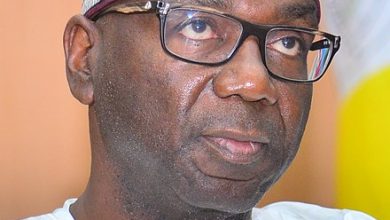Gov Ahmed: Providing a stable economy for Kwara

In the last few days, I have engaged myself with the Kwara State Medium Term Stimulus Plan (KSMTP) which was designed to demonstrate the full picture of Kwara states capital expenditure plans until 2019, towards eradicating or reducing the current state-wide N255 billion infrastructure deficit. Thanks to the Kwara State Internal Revenue Service which has made the document available to the public through the Nov/Dec 2017 edition of its special publication.
Looking back to the years 2011-2015 as a base, the KSMTSP considered three key principles relative to the continuity mantra of the incumbent administration: consolidation of gains made under the Bukola Saraki administration, strengthening the foundation of trust and performance and then activating and executing preliminary activities to anchor future actions leading to a string of the 2015-2019 agenda.
The stimulus plan is targeted at two broad platforms viz: basic infrastructure for social services such as education, health, power, road, sports and water and strategic infrastructure for economic transformation which would include broadband irrigation, mineral resources, tourism and transportation, etc. Giving a breakdown of the infrastructure deficit by sector, the Plan indicates that the state would need N33.3 billion for the provision of water, N66.53 billion for transportation and logistics, N103 billion for education, N30 billion for energy, N3.6 billion for sports, N12.24 billion for health and N6.2 billion spread across agricultural mechanisation enablers, power infrastructure enablers and ICT enablers. This amount represents what is needed to achieve standard availability and accessibility benchmarks according to international best practices, across the 16 local government areas of the state.
For a state whose internally generated revenue in 2014 was a meagre N12.37 billion and even a mere N7.9 billion in 2015, raising N255 billion in four years without selling the state to creditors, literarily, must be a daunting task, if not an impossibility. But not Dr Ahmed. Dr Bukola Saraki knew the burden and saw through the cloud before endorsing Ahmed to succeed him and carry to a new height the milestone reached between 2007 through 2011.
The challenges gave birth to the recreation of the state’s internal revenue machinery, culminating in a repositioned KWIRS that would be a key drive in the eventual emergence of a Kwara state that would rank comfortably among its peers in the country. This becomes all the more imperative given what other states like Lagos and Kano have achieved in the area of IGR.
Despite enormous challenge and opposition from those who wanted to maintain the status quo antics of corruption and leakages in common resources, Governor Ahmed reformed the processes, human resources and the techniques to reach the current level of efficiency. And the result is already showing; in 21 months (October 2015-October 2017), KWIRS madeN36 billion, dsspite the challenging economic climate. This demonstrates beyond predictions that with a better economic atmosphere, the dream of an annual IGR of N36 billion is now not impossible in the state. When this is achieved, the administration of Governor Abdulfatah Ahmed would have created a legacy that future regimes in the state would continue to leverage on to build the Kwara of our collective dream.
But beyond KWIRS, there is another legacy of the administration that stems from the stimulus plan worth considering. And that is the concept of the financial vehicle designed for execution of infrastructure development in the state. This model is aptly tagged, Infrastructure Fund Kwara (IF-K). The model emerged following the exit of the state from payment of outstanding capital development bond and the realisation that moving to commercial loans with its huge interest rates would not support the desire to significantly reduce the N255 billion infrastructure gap.
Under If-K, the state sets aside N500 million from the IGR every month and every quarter shares the accumulated N1.5 billion among contractors on high-end capital projects. The beauty of the model is that contractors are assured of payment and are therefore are confident of doing business with the government, seeking short-term funding for projects until the three-month maturity of their slots in the IF-K. As expected, the N500 million monthly is actually not idle, but invested to yield rates to the government.
Governor Ahmed led the team that developed the model and he is confident of its success given what he said is the overwhelming successes of such schemes in other economies that have adopted it to meet their infrastructure needs.
It is this model that is funding the ongoing capital intensive projects such as the Diamond Underpass in Geri Alimi, the dualisation of Sango-UITH road, the two campuses of KWASU, the new secretariat complex etc, simultaneously without the state having to borrow either from the capital or commercial market. When the model was unveiled to the public, stakeholders and project partners present at the event expressed confidence over the funding model. For instance, representatives of major banks such as GTB, Sterling Bank and contractors who have partnership with the state, said it will provide comfort for contractors, generate job for the youths and put an end to the negative experiences of abandoned projects in the state.
Mr. Nicholas Gamade, Managing Director of Investment One, has been approved by law to oversee the utilisation of the fund as well as marketing it to prospective investors, and according to him, from experience, the IF-K model has not been done anywhere in Nigeria.
During the event, Gov Ahmed assured stakeholders about the call for transparency in the utilisation of the fund. The governor also disclosed plans by his administration to inject over N5.8 billion into the states economy through the IF-K within 10 months, expressing confidence that the fund injection will help keep contractors in business and have a spiral effect on employment generation.
The IF-K is also billed to address the state’s N11.1billion indebtedness to contractors on ongoing projects, according to Ahmed who noted that already N1.7 billion of the amount has been paid to showcase the seriousness of his administration on the issue.
His words: Under IF-K, funds will be disbursed on a quarterly basis. In order to ensure accountability, and insulate the funds from political control, the IF-K will be managed by a reputable investment company, Investment One, which has been appointed by law as trustee for the scheme.
Investment One is also to market the fund to potential investors and mitigate against payment risks by ring-fencing the funds and limiting their utilization to the approved purposes for which they have been earmarked. In other words, the trustees are independent of the state government, and will only disburse funds upon the presentation of a certified certificate of completion and at agreed project milestones. As an added measure to ensure quality standards, the certificate of completion is also subject to further authentication by an independent project inspector. IF-K is therefore not susceptible to interference from any other party.
Given the benefits of stable and reliable funding provided by IF-K, I state without any equivocation that the era of abandoned projects is over in Kwara State, Ahmed assured the public, adding that as a demonstration of this determination, all ongoing and new projects will be funded to completion under the IFK before the end of my tenure. No doubt, apart from a rejuvenated internal revenue gyration platform, the creation of a unique model to spend accrued income from the peoples tax, is also another milestone of the Ahmed administration. It will remain a legacy.




